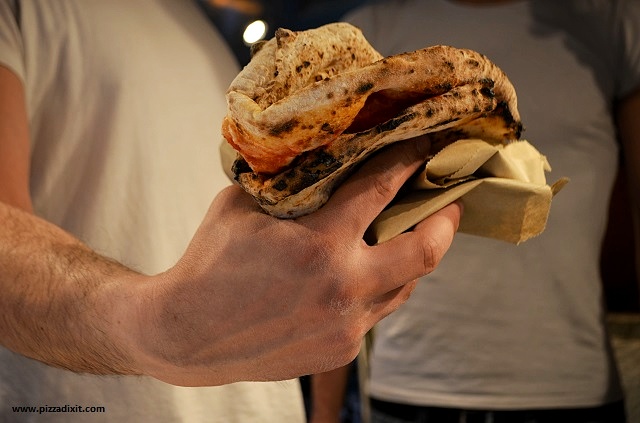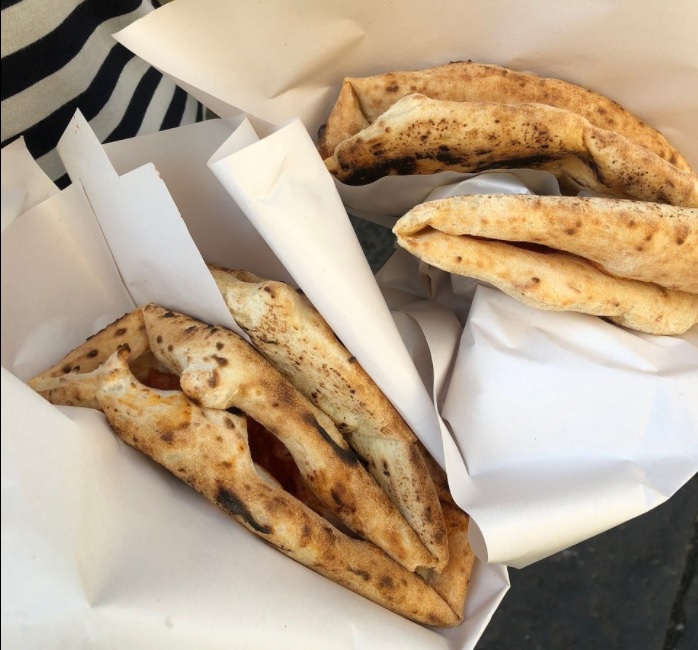
Pizza a portafoglio is an icon of street food in Naples. But it is not well known abroad. Do not worry, here I am to tell you everything about this particular kind of pizza, one of the most beloved foods in my hometown.
What is pizza a portafoglio
How do you eat a pizza a portafoglio
Where to eat pizza a portafoglio in Naples
Pizza a portafoglio in other countries
Pizza a portafoglio: recipe for home cooking
What is pizza a portafoglio?
Pizza a portafoglio is a pizza of smaller size, wrapped in straw or oven paper, and folded twice on its sides. Its Italian name could be loosely translated as “wallet pizza”: that’s because the way is folded reminds the way a wallet is closed. It is also known as “pizza a libretto”, where libretto means “small book”.
You can buy a pizza a portafoglio everywhere in Naples. Not just from a pizzeria, but also from bakeries and delis. It is perfect to calm down your cravings in case you don’t have time to stop for a full lunch. In Naples, we could crave pizza at any time: even when we’re just walking back home for dinner, we could feel that need for a soft dough, topped with tomato sauce and mozzarella. This also happens because walking in Naples you encounter a pizzeria every five meters, and it’s hard to resist the temptation.
Of course, we can’t spoil our appetite, ruining all the sacrifices made by our mother (or wife, or husband) to prepare us a nice dinner. That’s why pizza a portafoglio is the solution: it only serves the purpose of calming your hunger for a while, without filling your stomach.

The history of pizza a portafoglio is a natural evolution of the Neapolitan pizza tradition. Neapolitan pizza’s main feature is the dough, soft and elastic, that you can fold on its side, something you can’t do with other kinds of pizza. Also, Neapolitan pizza was always meant to be street food. The low price and the fact that can be taken away means that often people buy it and eat it few meters away from the pizzeria, sitting on a wall or a staircase.
Therefore, pizza a portafoglio is even more convenient: it’s smaller, easier to handle, and cheaper. It costs around 1-1.50 euros. That’s why is the “people food”, as it’s loved by anyone, students, workers, homeless people, and any social class. It makes everyone happy.
How do you eat a pizza a portafoglio?
Pizza a portafoglio is served smoking hot, open on a sheet of oven paper, or straw paper. Rarely is served on a paper plate. Sometimes it is given to you folded already. Otherwise, it’s up to you to fold it first on one side and then on the other side. Remember, how it reminds you of a wallet?
Pizza a portafoglio is not the same everywhere. The ones made in a pizzeria are better, as you can buy them fresh. But you need to remember, it’s not just a pizza of a smaller size. The crust is less soft, there’s less tomato sauce on top, and only a small cube of fiordilatte cheese. Do not forget: it is conceived to be folded and eaten in a short time. A larger amount of ingredients would make the pizza spill over everything, making a big mess.
Where to eat pizza a portafoglio in Naples?

You can eat pizza a portafoglio basically everywhere in Naples. It’s impossible to list every place where you could buy one. But there are a few pizzerias mostly recognized to have the best pizza a portafoglio in Naples.
Antica Pizzeria Port’Alba (Via Port’Alba, 18): this pizzeria is considered the oldest in Naples, dating back to 1738. In the past was popular among the intellectuals, but also penniless students. This has not changed much in the centuries, since the pizzeria is located in the University area of the city. It’s just at the beginning of a street which is famous for its bookshops and the second-hand book stands. You can satisfy your appetite for culture here, the same way you can do with your hunger, in both cases with only a few euros. The pizzeria displays its pizza a portafoglio all day long.

Pizzeria Di Matteo (Via dei Tribunali, 94): Salvatore Di Matteo’s pizzeria is one of the most famous among the pizzerias located on the street considered the “open-air museum of Neapolitan pizza”. There’s always a big crowd outside. Some of them are waiting to sit inside, some for their pizza to take away. But some other people are in line to buy one of the street food specialties on display. The pizza a portafoglio is of course one of those. It became particularly famous here thanks to a special visit: US president Bill Clinton, who, in 1994, was in Naples for the G7. The picture where he enthusiastically devours the pizza a portafoglio is now history.
Pizzeria Tutino dal 1935 (Via Cesare Carmignano, 79): it is generally considered the place to go when you arrive in Naples through the Circumvesuviana train at Porta Nolana station. The area around is pretty poor, and it really represents the old, authentic side face of the city. The same thing can be told for this pizza a portafoglio: simple, cheap and “verace”.

Pizzeria Errico Porzio (Via Alessandro Scarlatti, 84): the Vomero neighborhood is located on the hills of Naples, and it is very different from the old town. It’s uptown, so it is less common to find that kind of food that represents the poor traditions of the street people. That’s why Errico Porzio had a good intuition: opening one of his pizzerias here and selling his pizza a portafoglio. Considering this is in an upscale area, though, the price is above the average.
Pizza a portafoglio in other countries
As pizza has become pretty popular abroad in the street food format, it is quite obvious to think that pizza a portafoglio is sold in many places outside Italy. Unfortunately, this is not always true: some people have tried to popularize this concept, but later they’ve decided to stick to the traditional pizza, served and sliced on a paper plate.
The most popular kind of Neapolitan pizza abroad indeed comes according to the “contemporary” approach: with the inflated crust, and a variety of ingredients generously poured on top. This from one side makes the pizza worth every penny spent (as abroad it is usually way more expensive than in Naples); from the other, though, it makes it impossible to fold it, as all the ingredients would be spilled over from every side.
That’s why the concept of Neapolitan pizza a portafoglio is generally unknown abroad.

Pizza a portafoglio: recipe for home cooking
What if we wanted to make a Neapolitan pizza a portafoglio at home? It’s hard with a domestic oven, but not impossible. Ideally, you should have an oven that reaches the temperature of 500°C/950°F to get the effect of the leopard spots on the crust and a soft dough. But with some tweaks here and there, you can get a decent result even with a traditional oven that only gets to 250°C/480°F.
How do I know? Because I tried myself, under the guidance of another home pizza maker. You can check this video on my Instagram profile: it’s mainly in Italian, but I do translate the procedure while I’m doing it.

Recipe for a pizza a portafoglio homemade (5 people)
What you need:
Flour 00 or 0 type: 540 gr (weak, 10/11% proteins)
Water: 350 gr
Salt: 6 gr
Fresh yeast: 2 gr
Olive oil: 10 gr (only for the electric oven)
Start pouring water into a bowl, and dissolve the yeast. Once done, add half of the flour, and start mixing with a spoon. You need to move the spoon always from down to the center. At first, the dough will be creamy, like a chow. Add slowly more flour to make it more compact, and at this point add the salt as well. Keep adding flour and mixing with the spoon, and you’ll see the dough will get a softer and more compact texture.
When you’ve used all the flour, and the dough is not sticky anymore, let it rest in the bowl for 10 minutes. Cover the bowl. Then, start kneading the dough with your hands, following the same procedure. If you are going to use an electric oven, this is time to add the olive oil. If you can get to higher temperatures, leave it. Keep kneading, and then let it rest for 20 minutes.
After 20 minutes, pour the dough on a worktop which you will have previously covered in some flour. Then, start doing the foldings: lift the dough from the center, then fold it on itself. Do it three times: that will strengthen the gluten structure. After three foldings, use your hands to round the dough. Then, put it back into the bowl, and cover it with a lid or a cling film.
Put the dough in the fridge for 8 hours: this will be the fermentation period. After that, take the dough out, and start balling up. Every dough ball should be 180 grams. Leave the balls proofing in a closed container for 4 hours.
It’s time to make pizza. The dough balls need to be stretched on a worktop covered with flour. Start gently pressing your fingers from the center to the borders, turning the dough a couple of times. Use the slapping technique to stretch it further, or use your fists (as shown in the video).
When done, start with the toppings. The classic ingredients for a pizza a portafoglio are the tomato sauce, and just a tiny bit of fiordilatte. But you can be creative.
If you are using an electric oven that only reaches 250°C/480°F, preheat it 10 minutes before the bake. Put the pizza in a tray on the lower part of the oven. Then, pour some water inside the oven and close it immediately: the steam that will generate will help moisten the dough.
After around 7 minutes, move the pizza to the upper side of the oven, as close as possible to the grill. This way, the crust will start to get charred. Don’t leave it too long, though, or it will burn. This is also the moment to add the fiordilatte cheese, if you decided to make a classic Margherita, so it will melt without burning.
After another 3 minutes, the pizza is ready. Wait for it to get a bit colder, then wrap it up in the oven paper. Make sure it folds in your hands, then bite. Buon appetito!
